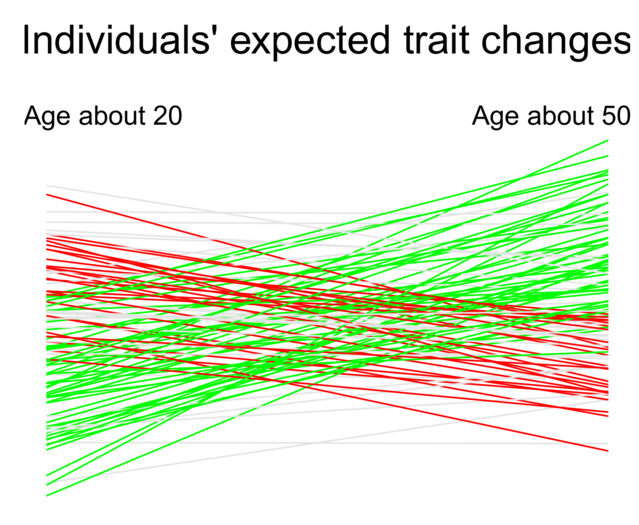Personality
How Age Changes Your Personality
Clear trends, but no one normative way to change
Posted April 24, 2022 Reviewed by Abigail Fagan
Key points
- Our personalities age differently, but some changes are slightly more common.
- Many middle-aged people are more conscientious and agreeable than typical youth.
- Negative emotions are also slightly less common among middle-aged people.
Regardless of how old people are, at least some of their personality traits are likely to change. Yet how exactly an individual's traits change is almost unpredictable.
But how does growing older itself change personality traits? How does a typical middle-aged person differ from a typical high schooler?
Psychologists can study this by following a group of people and comparing their trait scores measured at different points in their lives. This takes a lot of patience and effort. For example, to see how people change from age 20 to 50 years, researchers have to follow them for 30 years.
Alternatively, researchers can compare trait scores of people who already are at different ages, assuming that their differences are because of age rather than any other generational divide. This strategy is much easier and quicker.
Luckily the two approaches paint a broadly similar picture of how personalities tend to change with age.
Not Just One Way to Change
Imagine how people grow. They end at different heights and grow at different paces, but most follow a broadly similar growth trajectory: It is normative to grow until later teenage years and then level off. At age 18, very few are shorter than a typical 8-year-old, and almost no one grows shorter between ages 8 and 18 years.
Personality traits develop very differently:
- Development doesn't stop in adulthood—changes can happen all the time.
- There is no one way to change that is clearly normative—people can go up and down in any trait as they age.
But still, some patterns are more common than others.
The Slightly More Common Ways to Change
Personality trait change is most thoroughly studied for adults up to about the eighth life decade. Here I focus on changes from the early 20s to 50s because the findings are less consistent and more complex for later decades.
Many stereotypes are almost entirely incorrect, including national stereotypes (nationality makes barely any difference in personality). But while not entirely correct, people’s beliefs about how age changes personality traits are not at least wildly inaccurate. They get the directions of changes right but overstate their strength.
For example, many believe that people tend to get kinder, more cooperative, organized, and dutiful as they age. And indeed, such personality changes are slightly more common among people than the opposite changes.
In terms of the Big Five personality traits, becoming more agreeable, conscientious, and emotionally stable over time is more common among adults than changing in the opposite directions. Researchers call these trends personality maturation because high agreeableness, conscientiousness, and emotional stability are desirable and tend to go with better life outcomes.
For the remaining two Big Five traits, extraversion and openness, it is less clear whether people are likelier to go up, down, or stay the same. Studies often report different results, depending on their methodologies.
A Thought Experiment
Let's play with a thought experiment to put some numbers on these changes. Suppose you run a huge study and measure millions of people’s Big Five personality traits. For each trait, your participants receive feedback on their scores:
- Low (bottom third among all participants)
- Medium (middle third)
- High (top third)
Suppose you randomly select 1,000 20-year-olds and pair each with a randomly selected 50-year-old. For each Big Five trait, you can now ask the following question:
How likely is the older pair member to get higher feedback than the younger person?
Across many studies that have measured people’s agreeableness and conscientiousness in several countries with different personality tests, people score just over half a standard deviation higher at age 50 than at age 20, on average. For emotional stability, the age difference is probably somewhat smaller.
Half a standard deviation? This number can get researchers excited but doesn't say much to most people. To give it a meaning, we can translate it into our thought experiment as follows:*
- In about 50 percent of pairs, the older person gets higher feedback
- In about 30 percent of pairs, both get the same feedback
- In about 20 percent of pairs, the younger person gets higher feedback

So, for agreeableness and conscientiousness, about half of people are expected to score higher in middle age than those who recently left high school. Another half may either stay the same—perhaps having gone up and down a few times in between—or even score lower as they become older. For emotional stability, these proportions are a little more equal.
Simultaneously Following All Age Trends Is Rarer
While each of the three traits—agreeableness, consciousness, and emotional stability—is likelier to increase than decrease with age, it is less common for any given person to experience all of these trait increases.
This is just how math works: The chances that all of several things happen as expected are lower than the chances that each of them individually happens. For example, if the probability of expected changes in each of two traits is 0.5, then the probability of both traits changing as expected is 0.5 x 0.5 = 0.25, or 25 percent. For three traits, the probability that all goes as expected is even smaller.**
So, there really is no one normative way for people to change. Many ways to change are entirely normal, not only in terms of what we think is OK but also statistically.
This, in turn, means that it is not easy to predict how exactly any given person’s personality traits will change as they age.
*These percentages come from a statistical simulation.
**Sometimes, different traits change together, which makes the probability that they all change in their expected directions slightly higher. But this does not alter the main point.
Facebook image: Anna Nahabed/Shutterstock
LinkedIn image: Bricolage/Shutterstock




